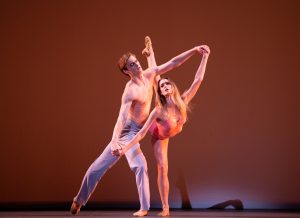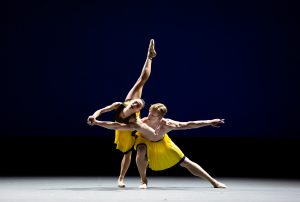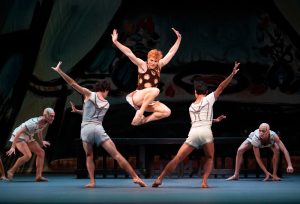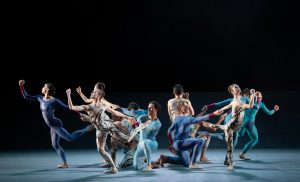
Miami City Ballet hedged its bets for the last program of season by presenting the world premiere of an elaborately ambitious collaborative work together with the company premieres of two acclaimed contemporary pas de deux and a dated repertory warhorse — George Balanchine’s The Prodigal Son.
It was an evening of strong performances by all the company dancers, but the night (April 29 at the Kravis Center) belonged to the couples in the two pas de deux, Hannah Fischer and Cameron Catazaro, and Nathalia Arja and Chase Swatosh, as well as to Alexander Peters, who breathed vibrant new life into the lead role of the Prodigal Son.
Over the season, there have been some exciting change-ups in the casting of lead roles. Between company members moving up the ranks of MCB and a slew of excellent new dancers joining the company, it has been a pleasure to watch these dancers soar as they took on new and challenging roles.
Fischer and Catazaro, both tall and elegant, were absolutely stunning in the intimate contemporary pas de deux After The Rain. Beautifully paired, they caught the essence and purity of the love duet choreographed by Christopher Wheeldon. The duet, which was created in 2005 for New York City Ballet, was part of a two-part ballet but is now mostly performed on its own.
Wheeldon chose the achingly beautiful minimalist score of Spiegel Im Spiegel (Mirror in the Mirror) to pair with his pure movement. Written in 1978, it is one of the best-known and most-performed pieces by Estonian composer Arvo Pärt and it was expertly played by violinist Mei Mei Luo and pianist Francisco Rennó.
I have seen this work performed many times by many different artists and the beauty of the work always touches me. Every time, the perfect melding of the movement and the music mesmerizes me as I watched the different casts of dancers create their own individual magic. This MCB cast was no exception. After the last two years of COVID-19, the slight seriousness in Fischer’s and Catazaro’s portrayal seemed perfect as if that time of isolation had somehow deepened their connection and matured their love as they became one in their seemingly effortless lifts that evolved out of their tender partnering or as they danced side by side looking ahead with a shared vision.

Arja and Swatosh, on the other hand, were two lively individuals in the lighthearted Herman Schmerman Duet choreographed by William Forsythe. Arja, who has been conspicuously absent this season at the Kravis Center, was back and as spirited and quick-footed as ever as she cajoled and directed her counterpart Swatosh.
In the middle of the duet, Swatosh, who has a natural talent for contemporary movement, crushed his solo even though it was difficult to see much of Swatosh’s beautiful quality in the off-balance movement because he was wearing black pants, black T-shirt and black shoes against a dark background. In the second part of the duet, it was a visually jarring when Arja returned after Swatosh’s beautiful solo dressed in an electric-yellow pleated skirt, and then Swatosh returned onstage boldly bare-chested and bare-legged, wearing exactly the same yellow skirt.
Their competitive sparing escalated as they tried to out-dance each other. The drastic change in costumes (which were designed by Gianni Versace) was hard to decipher. Was it meant to be a mocking statement towards feminism or a nod to gender-bending? Perhaps the haute couture designer just wanted to make a daring fashion statement.
The score for this work was a quirky electronic composition called Just Ducky by Dutch composer Thom Willems, a longtime collaborator of Forsythe. This competitive and fun duet was actually added to a small group work that Forsythe had originally choreographed for New York City Ballet’s Diamond Project (1992) but when the ballet was revived seven years later, all that was kept was the pas de deux.

A real standout in Friday evening’s program at the Kravis Center was the the red-haired dynamo Alexander Peters, who has really come into his own this season. Every time he has been onstage, he has been memorable. Whether dancing the lead male role in Rubies or taking on the lead in The Prodigal Son, one of the most famous roles of founder and former artistic director of MCB, Edward Villella, Peters took it all in stride.
On this night, it was the combination of his onstage physical energy, decisive clean technique and the authenticity in his interpretation of his role that gave a new spark of life to this historic ballet.
The Prodigal Son is the most well-known of Balanchine’s early ballets. Choreographed in 1929 for Serge Diaghilev’s Ballet Russes, it is a retelling of the biblical story in a one-act story ballet. The costumes and set are the original designs by Georges Rouault and the score for the ballet is by Sergei Prokofiev. Following the story, Peters leaves the home of his father to be tempted by a collection of nine bald characters (who are described as his Drinking Companions and are a cross between a circus performers and an army of soldiers). Their antics and strange caterpillar-like movement surrounded Peters and led him to be seduced by the provocative Siren convincingly danced by the lovely newcomer, Dawn Atkins.
The other offering of the evening was The Source, the world premiere that opened the program. While there is much to admire visually in this expansive work, the innocuous and somewhat murky choreography by Claudia Schreier barely simmered beneath the strong visual designs of the set, lighting and film projections. Despite the big bucks that were clearly spent on this commissioned multidisciplinary project, The Source did not resonate as well as the other less gift-wrapped works on the program.

A slow-moving visual prologue introduced the work. Silhouetted fishing boats against a gray sky filled the full width of the stage as figures dressed in drab work clothes and caps crossed the stage with a downtrodden air. Projections of a few large drops of black substance were projected onto transparent scrims and, as they fell from above, they set off a transition. The set changed into an underworld environment shrouded with long, hanging strands where two different sets of eight dancers met, paired and exchanged dramatic gestures only to separate again. Little seemed to evolve. The set then reverted back to the silhouetted fishing harbor where the figures once again passed by each other with a downtrodden air.
Lasting 30 minutes, Schreier’s large ensemble work — though admirable in scope — was vague and unsatisfying. The concept was ambitious, but it was also cumbersome. The long explanation in the program notes did little to advance the work. Using the familiar format of an ABA structure to show a repeating cycle, Schreier’s message that the only viable path for grief is acceptance seemed belabored. If the copious program notes and the elaborate stage visuals were taken away, the choreography wouldn’t hold up.
Schreier’s husband Adam Barish was the director of the work, Jason Ardizzone-West was the scenic designer and Abigail Dupree-Polston was the costume designer. Lighting design was by Mark Stanley and the projection design was by Alex Basco Coch. The music was a diversified collection of music by Frank Zappa, William Grant Still, Alexina Louie and Julius Eastman, whose Femenine was arranged by Gary Sheldon, the musical director and principal conductor of the Opus One Orchestra.